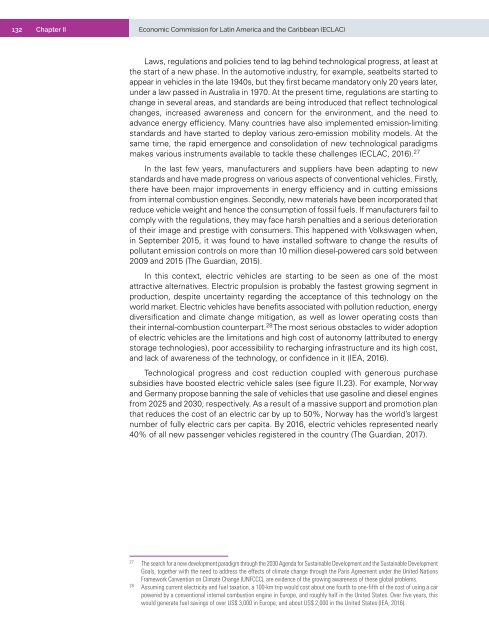Foreign Direct Investment in Latin America and the Caribbean 2017
This publication sets out and analyses the main foreign direct investment (FDI) trends in the countries of Latin America and the Caribbean. The 2017 edition shows that the region is at a difficult juncture. FDI inflows declined by 7.9% in 2016, to US$ 167.043 billion, representing a cumulative fall of 17.0% since the peak in 2011. The fall in commodity prices continues to affect investments in natural resources, sluggish economic growth in several countries has slowed the flow of market-seeking capital, and the global backdrop of technological sophistication and expansion of the digital economy has concentrated transnational investments in developed economies.
This publication sets out and analyses the main foreign direct investment (FDI) trends in the countries of Latin America and the Caribbean. The 2017 edition shows that the region is at a difficult juncture. FDI inflows declined by 7.9% in 2016, to US$ 167.043 billion, representing a cumulative fall of 17.0% since the peak in 2011. The fall in commodity prices continues to affect investments in natural resources, sluggish economic growth in several countries has slowed the flow of market-seeking capital, and the global backdrop of technological sophistication and expansion of the digital economy has concentrated transnational investments in developed economies.
You also want an ePaper? Increase the reach of your titles
YUMPU automatically turns print PDFs into web optimized ePapers that Google loves.
132 Chapter II Economic Commission for Lat<strong>in</strong> <strong>America</strong> <strong>and</strong> <strong>the</strong> <strong>Caribbean</strong> (ECLAC)<br />
Laws, regulations <strong>and</strong> policies tend to lag beh<strong>in</strong>d technological progress, at least at<br />
<strong>the</strong> start of a new phase. In <strong>the</strong> automotive <strong>in</strong>dustry, for example, seatbelts started to<br />
appear <strong>in</strong> vehicles <strong>in</strong> <strong>the</strong> late 1940s, but <strong>the</strong>y first became m<strong>and</strong>atory only 20 years later,<br />
under a law passed <strong>in</strong> Australia <strong>in</strong> 1970. At <strong>the</strong> present time, regulations are start<strong>in</strong>g to<br />
change <strong>in</strong> several areas, <strong>and</strong> st<strong>and</strong>ards are be<strong>in</strong>g <strong>in</strong>troduced that reflect technological<br />
changes, <strong>in</strong>creased awareness <strong>and</strong> concern for <strong>the</strong> environment, <strong>and</strong> <strong>the</strong> need to<br />
advance energy efficiency. Many countries have also implemented emission-limit<strong>in</strong>g<br />
st<strong>and</strong>ards <strong>and</strong> have started to deploy various zero-emission mobility models. At <strong>the</strong><br />
same time, <strong>the</strong> rapid emergence <strong>and</strong> consolidation of new technological paradigms<br />
makes various <strong>in</strong>struments available to tackle <strong>the</strong>se challenges (ECLAC, 2016). 27<br />
In <strong>the</strong> last few years, manufacturers <strong>and</strong> suppliers have been adapt<strong>in</strong>g to new<br />
st<strong>and</strong>ards <strong>and</strong> have made progress on various aspects of conventional vehicles. Firstly,<br />
<strong>the</strong>re have been major improvements <strong>in</strong> energy efficiency <strong>and</strong> <strong>in</strong> cutt<strong>in</strong>g emissions<br />
from <strong>in</strong>ternal combustion eng<strong>in</strong>es. Secondly, new materials have been <strong>in</strong>corporated that<br />
reduce vehicle weight <strong>and</strong> hence <strong>the</strong> consumption of fossil fuels. If manufacturers fail to<br />
comply with <strong>the</strong> regulations, <strong>the</strong>y may face harsh penalties <strong>and</strong> a serious deterioration<br />
of <strong>the</strong>ir image <strong>and</strong> prestige with consumers. This happened with Volkswagen when,<br />
<strong>in</strong> September 2015, it was found to have <strong>in</strong>stalled software to change <strong>the</strong> results of<br />
pollutant emission controls on more than 10 million diesel-powered cars sold between<br />
2009 <strong>and</strong> 2015 (The Guardian, 2015).<br />
In this context, electric vehicles are start<strong>in</strong>g to be seen as one of <strong>the</strong> most<br />
attractive alternatives. Electric propulsion is probably <strong>the</strong> fastest grow<strong>in</strong>g segment <strong>in</strong><br />
production, despite uncerta<strong>in</strong>ty regard<strong>in</strong>g <strong>the</strong> acceptance of this technology on <strong>the</strong><br />
world market. Electric vehicles have benefits associated with pollution reduction, energy<br />
diversification <strong>and</strong> climate change mitigation, as well as lower operat<strong>in</strong>g costs than<br />
<strong>the</strong>ir <strong>in</strong>ternal-combustion counterpart. 28 The most serious obstacles to wider adoption<br />
of electric vehicles are <strong>the</strong> limitations <strong>and</strong> high cost of autonomy (attributed to energy<br />
storage technologies), poor accessibility to recharg<strong>in</strong>g <strong>in</strong>frastructure <strong>and</strong> its high cost,<br />
<strong>and</strong> lack of awareness of <strong>the</strong> technology, or confidence <strong>in</strong> it (IEA, 2016).<br />
Technological progress <strong>and</strong> cost reduction coupled with generous purchase<br />
subsidies have boosted electric vehicle sales (see figure II.23). For example, Norway<br />
<strong>and</strong> Germany propose bann<strong>in</strong>g <strong>the</strong> sale of vehicles that use gasol<strong>in</strong>e <strong>and</strong> diesel eng<strong>in</strong>es<br />
from 2025 <strong>and</strong> 2030, respectively. As a result of a massive support <strong>and</strong> promotion plan<br />
that reduces <strong>the</strong> cost of an electric car by up to 50%, Norway has <strong>the</strong> world’s largest<br />
number of fully electric cars per capita. By 2016, electric vehicles represented nearly<br />
40% of all new passenger vehicles registered <strong>in</strong> <strong>the</strong> country (The Guardian, <strong>2017</strong>).<br />
27<br />
The search for a new development paradigm through <strong>the</strong> 2030 Agenda for Susta<strong>in</strong>able Development <strong>and</strong> <strong>the</strong> Susta<strong>in</strong>able Development<br />
Goals, toge<strong>the</strong>r with <strong>the</strong> need to address <strong>the</strong> effects of climate change through <strong>the</strong> Paris Agreement under <strong>the</strong> United Nations<br />
Framework Convention on Climate Change (UNFCCC), are evidence of <strong>the</strong> grow<strong>in</strong>g awareness of <strong>the</strong>se global problems.<br />
28<br />
Assum<strong>in</strong>g current electricity <strong>and</strong> fuel taxation, a 100-km trip would cost about one fourth to one-fifth of <strong>the</strong> cost of us<strong>in</strong>g a car<br />
powered by a conventional <strong>in</strong>ternal combustion eng<strong>in</strong>e <strong>in</strong> Europe, <strong>and</strong> roughly half <strong>in</strong> <strong>the</strong> United States. Over five years, this<br />
would generate fuel sav<strong>in</strong>gs of over US$ 3,000 <strong>in</strong> Europe, <strong>and</strong> about US$ 2,000 <strong>in</strong> <strong>the</strong> United States (IEA, 2016).


















